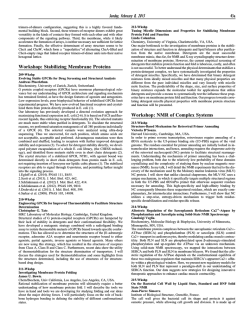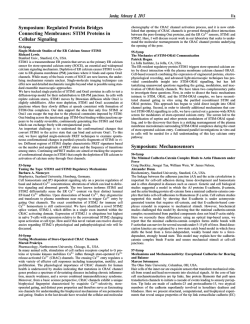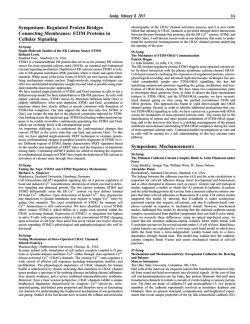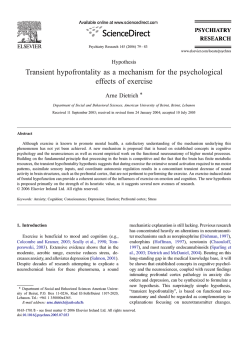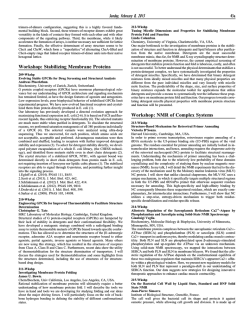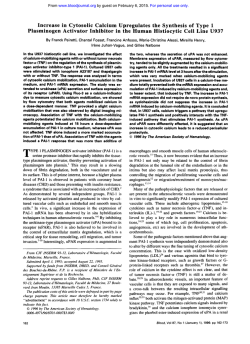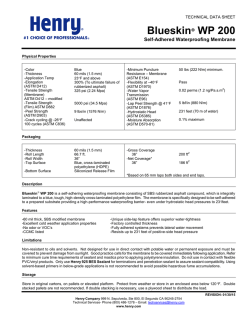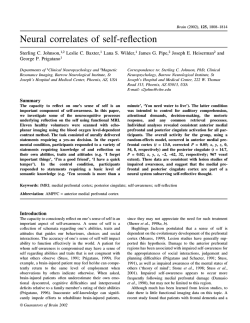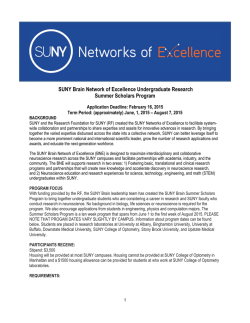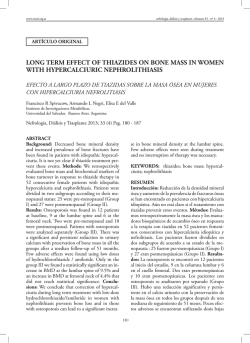
Cortical Alveoli of Paramecium: a Vast
Published April 1, 1991
Cortical Alveoli of Paramecium: a Vast
Submembranous Calcium Storage Compartment
Nicole Stelly,* Jean-Pierre Mauger,* Michel Claret,* a n d A n d r 6 Adoutte*
*Laboratoire de Biologie Cellulaire 4, UnR6 de Recherche Associ6e 1134 du Centre National de la Recherche Scientifique,
B~timent 444; *Unit6 de Recherche de Physiologie et Pharmacologie Cellulaires, Institut National de la Sant~ et de la Recherche
M6dicale, B~timent 443, Universit6 Paris-Sud, 91405 Orsay-Cedex, France
This fraction pumped calcium very actively in a
closed membrane compartment, with strict dependence
on ATP and Mg 2÷. The pumping activity was affected
by anti-calmodulin drugs but no Triton-soluble
calmodulin binding protein could be identified, using
gel overlay procedures. The high affinity of the pump
for calcium (Km = 0.5 t~M) suggests that it plays an
important role in the normal physiological environment of the cytosol. This may be related to at least
three calcium-regulated processes that take place in
the immediate vicinity of alveoli: trichocyst exocytosis, ciliary beating and cytoskeletal elements dynamics
during division.
HE cell membrane of Paramecium, as that of most ciliates (Allen, 1971; de Puytorac, 1984), is underlain by
a vast network of membrane vesicles known as cortical
alveoli (Fig. 1). The ultrastructural analysis of Allen (1971)
in Paramecium and of Satir and Wissig (1982) in Tetrahymena has shown that the alveoli are in fact interconnected,
making up a continuous network that is only interrupted at
the points of emergence of cilia and those of implantation of
secretory vesicles. The alveoli thus appear to constitute an
insulating layer between the cell membrane and the cytoplasm. The biological function of this layer has, however, remained unknown. On the basis of their morphology, especially their close apposition to the plasma membrane, Allen
and Eckert (1969) and later Satir and Wissig (1982) suggested that the alveoli constitute a calcium compartment that
resembles muscle sarcoplasmic reticulum. Indeed, the cortex of Paramecium contains three major organellar systems
which are known to be regulated by calcium: the several
thousand cilia which are covered by the plasma membrane,
the approximately thousand exocytotic membrane vesicles
known as trichocysts, which are attached just beneath the
plasma membrane and several cytoskeletal networks which
underly the cell surface (see Fig. 1, a and b). The involvement of calcium has been best characterized in ciliary beating. Both orientation of the power stroke and frequency of
beating are controlled by the concentration of calcium within
the intraciliary space (Eckert and Brehm, 1979; Kung and
Saimi, 1982; Bonini et al., 1989). The penetration of calcium within the ciliary lumen has been intensively studied
and is known to depend on the presence of a number of ion
channels in the ciliary membrane, the best studied being the
fast voltage-sensitive calcium channel (see Ramanathan et
al., 1988 and Machemer, 1988 a, b for reviews). The return
to the very low intraceUular calcium concentration ( < 1 0 -7
M) that characterizes resting cells (Kung and Saimi, 1982),
after the surge due to activation of the ciliary channels, is
thought to be dependent on a temperature-sensitive Ca pump
(Browning and Nelson, 1976). However, the location of the
corresponding ATPase and the indentification of the path
taken by calcium ions have remained elusive in spite of the
fact that several Ca-ATPases have been identified in cortex
and cilia (Bilinski et al., 1981; Riddle et al., 1982; Andrivon
et al., 1983; Doughty and Kaneshiro, 1983; Travis and Nelson, 1986; Levin et al., 1989). In addition to a Ca pump embedded in the ciliary membrane, the possible occurrence of
a calcium sequestering device at the base of the cilium is conceivable (Schultz and Klumpp, 1988; Bonini et al., 1989).
Trichocyst extrusion is also known to be strictly dependent
on the presence of exogenous Calcium (Plattner et al., 1985;
Satir, 1989), and has recently been demonstrated to be associated with a calcium influx (Kerboeuf and Cohen, 1990),
but an additional intraceUular store may also be involved (see
T
© The Rockefeller University Press, 0021-9525191/04/103/10 $2.00
The Journal of Cell Biology, Volume 113, Number 1, April 1991 103-112
103
Downloaded from on October 2, 2016
Abstract. The plasma membrane of Paramecium is
underlain by a continuous layer of membrane vesicles
known as cortical alveoli, whose function was unknown but whose organization had suggested some
resemblance with muscle sareoplasmic reticulum. The
occurrence of antimonate precipitates within the alveoli first indicated to us that they may indeed correspond to a vast calcium storage site. To analyze the
possible involvement of this compartment in calcium
sequestration more directly, we have developed a new
fractionation method, involving a Percoll gradient, that
allows rapid purification of the surface layer (cortex)
of Paramecium in good yield and purity and in which
the alveoli retain their in vivo topological orientation.
Published April 1, 1991
Materials and Methods
Strains and Culture Conditions
The d4-2 stock of Paramecium tetraurelia was used as the wild-type reference strain throughout this study (Sonneborn, 1975). Mutant tam8, which
forms morphologically normal trichocysts which never attach to the cell surface (Beisson and Rossignol, 1975; Lefort-Tran et al., 1981), was isolated
in stock d4-2. Mutant pawn d4-500 (Satow and Kung, 1980) totally lacks
functional voltage-sensitive Ca 2+ channels. It was isolated in stock 51 of
Paramecium tetraurelia, a close relative of stock d4-2.
The cells were grown at 27"C in wheat grass powder medium (Pines In-
The Journal of Cell Biology, Volume 113, 1991
ternational Co., Lawrence, KS) buffered with 0.75 g/liter Tris-HCl, 0.2 g/l
NaH2PO4 and 0.75 g/l Na2HPO4 and baeterized with Aerobacter aerogenes
the day before use. Before utilization, 0.5 #g/ml ~-sitosterol was added.
Cortex Purification
Cells were harvested from early stationary phase cultures (2,500-5,000
ceils/nil; 6-12 liters of culture), using first an International Equipment Co.
(Ncedham Heights, MA) continuous flow centrifuge and, at the last steps,
a GOT (Giovanni Giaccardo Torino, Torino, Italy) centrifuge equipped with
pear-shaped oil-testing vessels. The pellets were washed twice in 20 mM
Tris-Maleate buffer (pH 7.8), 3 mM EDTA (homogenization medium,
HM; 1 according to Bilinski et ai., 1981). All subsequent steps were carried
out at 4"C. The cells were resuspended in two volumes of cold HM containing 0.25 M sucrose, in the presence of protease inhibitors (0.01 mg/ml
leupeptin and 1 mM PMSF; both from Sigma Chemical Co., St. Louis,
MO). They were transferred to a Potter homogenizer (reference no 3431El5, size A. Thomas, Philadelphia, PA) equipped with a Teflon pestle (0.15
mm clearance), and left to stand on ice for 10-15 min until complete immobilization. They were then submitted to ',~40 hand strokes; the extent of
cell breakage was monitored regularly by phase contrast microscopy.
Homogenization was terminated when "~95% of the cells had broken up,
yielding cortex fragments very heterogeneous in size but mostly detached
from gullets. After dilution in 30 vol of HM, the homogenate was centrifuged at 270 gm~ for 5 rain in a SS34 rotor (Sorvall Instruments, Div.,
Norwalk, CT). The crude pellets was resuspended in a total volume of 1-3
ml HM and aliquots of 150 t~l were layered over 10-ml transparent tubes
containing a 25% Porcoll-250 mM sucrose solution in HM (12-24 tubes required). The tubes were spun at 27,500 rpm in a Beckman 40 fixed angle
rotor (Beckman Instruments, Fullerton, CA) for 20 rain (50000 gay) and
the bands recovered by pipetting.
For Ca 2+ uptake assays, each fraction was diluted in 5 volumes of HM
(without sucrose and EDTA), well mixed and spun in a Sorvail SS34 rotor
at 6000 rpm for 10 rain (4,300 gay). The pellets were resuspended in HM
sucrose without EDTA.
For gel electrophoresis, the pellets were directly resuspended in a small
volume of HM without sucrose and stored at -20"C. Aliquots were dissolved in SDS sample buffer (Laemmii, 1970) before loading on gels.
For EM, the pellets were washed by centrifugation in HM without sucrose to eliminate the percoll beads and directly resuspended in the fixative.
Protein concentrations were measured according to Lowry et al. (1951)
using BSA as a standard.
Gel Electrophoresis and Immunotransfer
The procedures were exactly those described in Ktryer et al. (1990). Antiband 4 polyclonal antibody (see Ktryer et ai., 1990 for nomenclature, preparation, and characterization) was raised against a high-molecular weight
band excised from preparative SDS-PAGE gels of crude cortex preparations.
Ca 2÷ Uptake Assay
Purified cortices were resuspended at 0.5-1 mg/ml in the incubation
medium containing: 250 mM sucrose, 20 mM Tris-maleate, pH 7.4, 5 mM
MgC12, 1.5 mM Na2-ATE 0.5-1 /~Ci 45Ca2+ and either 20/zM Ca 2+ or
0.2 mM and CaCI2 to yield the indicated free Ca 2+ concentration. The
mixture was incubated during the appropriate time at 27°C. The reaction
was stopped by diluting the mixture with 4 ml of the washing solution containing 250 mM sucrose and 40 mM NaC1, followed by filtration through
a Whatrnan GF/C glass fiber filter (Whatman Instruments, Maidstone, England). The filter was washed three times with the washing medium and
counted for radioactivity in a scintillation spectrometer.
The effect of potential inhibitors was checked by preincubating cortices
during 5 rain in incubation medium lacking ATP and containing the inhibitor. 45Ca uptake was then initiated by the addition of 1.5 mM ATP and
stopped as described above.
The total Ca 2+ concentrations were determined by atomic absorbtion
and adjusted at the desired concentrations. The free Ca 2+ concentration in
the presence of EGTA was calculated using a computer program as described by Fabiato and Fabiato (1979) and Burgess et al. (1983).
1. Abbreviation used in this paper: HM, homogenization medium.
104
Downloaded from on October 2, 2016
Adoutte, 1988 for review). Here again, it must be assumed
that calcium concentration is tightly controlled in the vicinity of the organelles to prevent their erratic firing; a nearby
membranous compartment could play this important role
and could also deliver at least part of the calcium trigger
upon proper stimulation. It is worth pointing out in this context that alveolar membranes are very tightly apposed to
those of trichocysts (Plattner et al., 1973). Finally, calcium
is known to play a role in the dynamics of some of the classical cytoskeletal fibers of higher eukaryotes (microtubules,
microfilaments). Microtubules as well as several other distinct cytoskeletal networks (Allen, 1971; Cohen and Beisson, 1988) are abundant in the cortex and, in addition, one
of its major nonactin filamentous network, the infraciliary
lattice, has recently been shown to be contractile and to be
made of one predominant calcium binding protein (Garreau
de Loubresse et al., 1988). Several of these subcortical
cytoskeletal networks undergo extensive disassembly followed by reassembly during the morphogenetic processes of
binary fission (Iftode et al., 1989). Fine tuning of calcium
concentration in the vicinity of the cortex is therefore probably also required to regulate this third category of cellular
events.
In this paper, we describe a direct test of the calcium sequestering function of alveoli. This was made possible by the
development of a fractionation method using Percoll gradients enabling the isolation, in good yield, of a very pure
cortical fraction, devoid of cilia. Mechanical homogenization of paramecia under mild conditions yields large cortical
fragments containing the alveoli still attached to the plasma
membrane. Cilia, which would constitute a serious contaminant in an assay seeking to measure calcium fluxes in
alveoli, are readily detached from cell bodies during the
homogenization procedure. The remaining difficulty with
Paramecium cortex fractionation is that cortical fragments
tend to cosediment with a specialized portion of the cell surface, the "gullet" (oral apparatus), whose numerous cilia are
not detached even under harsh deciliation and homogenization conditions. Previous work (Ktryer et al., 1990) has
shown that an elaborate six-step sucrose gradient allows the
separation of cortex fragments from gullets. Although excellent purity is obtained by this method, allowing qualitative
work to be carded out, its low yield precludes extensive biochemical tests. The methods described in this paper circumvent this difficulty by providing excellent physical separation
of deciliated cortex fragments from gullets and other contaminants. The procedure requires a relatively short time, allowing ion flux experiments to be carried out on the same
day. Using the cortical fraction, we show that it has all the
properties of an active calcium sequestering compartment.
Published April 1, 1991
Downloaded from on October 2, 2016
Figure 1. Ultrastructure of Paramecium cortex and sites of antimonate deposits. The surface of Paramecium, as observed in conventional
EM sections (a), consists in a continuous plasma membrane (pro) subtended by a single layer of large, tightly apposed membrane vesicles,
the alveoli (alv), which are interrupted only at the points of implantation of cilia (ci) through their basal bodies (bb) and trichocysts (n,
trichocyst tip; tb, trichocyst body). The alveoli are surrounded by an outer alveolar membrane (oam) in topological continuity with an
inner alveolar membrane (iam). They are subtended continuously by a membrane skeleton, the epiplasm, (ep). The epiplasm itself is interrupted at the ridges of the alveoli giving way to filaments known as the outer lattice (ol). Deeper in the cytoplasm, the filaments of the
infraciliary lattice (il) are found, running across the rough endoplasmic reticulum (rer) and the mitochondria (m). When cells are preincubated in anfimonate (b) dense deposits are observed within the alveoli and trichocyst tips (arrows). Both cross sections (central alveoli)
and more tangential ones (rightmost alveolus) show the deposits in alveoli preferentially located over the inner alveolar membrane. A few
grains are also visible in mitochondria. Bar, 0.5/~M.
(a) Standard Observations. Whole cells or cell fractions were fixed in
0.25% glutaraldehyde in 0.05 M Na Cacodylate, pH 7.4, 15 rain at 4°C and
postfixed in 2% OsO4 in the same buffer for 1 h at room temperature. After
washing in the buffer, the cells were preembedded in a fibrin clot, de-
hydrated in acetone, and embedded in Epon-Arldite. The sections were either observed unstained or after staining with uranyl acetate followed by
lead citrate.
(b) Ca Precipitation Experiments. Three major antimonate and one oxalate precipitation techniques were tested, along with minor variations in
each of them (Salisbury, 1982; Berruti et al., 1986; Mentr~ and Escaig,
Stelly et al. Paramecium Alveoli as a Calcium Compartment
105
Electron Microscopy
Published April 1, 1991
Downloaded from on October 2, 2016
Figure 2. Phase-contrast images of PercoU gradient fractions. (a) The typical appearance ofa 10-m125 % Percoll gradient tube after centrifugation of a crude Paramecium brei, obtained as described in Materials and Methods. T, trichocyst band; C, cortex band; G, gullet band.
Distances to the bottom of the tube are indicated in millimeters. (b) Phase-contrast image of a sample from the G (gullets) band. Five
gullets are seen in the field with their typical comma-shaped appearance and the numerous cilia still attached to them. (c and d) Phasecontrast images of samples from the C (cortex) band. Cortex fragments of various sizes can be easily recognized because of the regular
alignments of basal bodies they contain (small dark dots). The fraction is devoid of cilia and of gullets. Bars: (b) 10 #m; (c and d) 20 #m.
1988; Probst, 1986). The differences between these methods reside in the
type of fixative used, the concentration of antimonate, the buffeting conditions, and the order of addition of the reactants. Reproducible positive
results were obtained using slight modifications of Salisbury's (1982)
method. The cells were resuspended in a solution containing 2% K pyroantimonte, 20 mM sucrose, 20 mM glycine, adjusted to pH 7.4 and 2%
OsO4. After 1 h, the cells were washed in 0.05 phosphate buffer, pH 7.4,
then processed as above.
The first suggestion that alveoli may correspond to a calci-
um compartment was obtained using the pyroantimonate
histochemical procedure which is widely assumed to reveal
loosely bound, exchangeable calcium in the form of electron-dense deposits (reviewed by Wick and Hepler, 1982).
Although a variety of published assays were used (see Materials and Methods), positive results were obtained only
when the living cells were directly submitted to the antimonate solution in the presence of osmic acid. The other
methods either degraded the cell surface (for example when
some of the aldehydic fixatives were added together with antimonate) or prevented the formation of antimonate precipitates. Adding both the reactant and osmium simultaneously
probably established a compromise between local precipitation, ultrastructural preservation, and prevention of exces-
The Journal of Cell Biology, Volume 113, 1991
106
Results
Antimonate Precipitates Suggested that Alveoli
Contain Calcium
Published April 1, 1991
Figure 3. Ultrastructure of Percoll-purifiedcortex fragments. Two adjacent cortex strips in reverse orientation are seen. They contain many
of the elements described in the in situ configuration (Fig. 1 a), in particular the succession of alveoli (alv) with their inner and outer
membranes (iam and oam), together making up closedvesicles, located beneath the plasma membrane (pro) and subtended by the epiplasm
(ep). Basal bodies (bb) and the outer lattice (ol) are.conspicuous. Cilia and cytoplasmic organdies are absent. Bar, 0.5 #m.
Stelly et al. Paramecium Alveoli as a Calcium Compartment
PercoU Allowed Improved Purification of
Paramecium Cortex
To directly test the hypothesis of active calcium sequestration in the cortical alveoli of Paramecium, we searched for
a method of cell fractionation that would yield highly
purified cortical fragments less laboriously than with the sixstep sucrose procedure of Ktryer et al. (1990). Percoll gradients were chosen because of the excellent purification of
various forms of trichocysts of Paramecium from cortex
fragments previously observed by Sperling et al. (1987).
The formulation described in Materials and Methods was
reached after a number of semiempirical tests in which the
Percoll concentration, the run time, the centrifugal force,
and the total volume were progressively adjusted, whereas
the bands obtained were observed by phase-contrast microscopy. The aim was to obtain good separation of cortex fragments from gullets and other contaminants but also to try to
have the cortex sediment as a relatively sharp band to facilitate its recovery from the gradient tubes. The compromise
reached allowed the formation, through a short run, of a
somewhat fluffy cortex band, 3-5 mm thick, located quite
far from the nearest contaminants (10 and 25 mm for
trichocysts and gullets, respectively) (Fig. 2 a). This pattern
was extremely reproducible (>30 runs). Maximum protein
concentration that could be loaded on a 10-ml gradient tube
while maintaining good separation was 400 #g; the yield was
typically 100/~g of cortex per tube. 12-24 tubes were routinely run simultaneously providing 1-2 mg (exceptionally
up to 5 mg) of purified cortex in ,'~4-5 h.
A variety of tests established the purity of the fractions obtained through these gradients. First, light and electron microscopy showed the cortex fraction to be totally devoid of
cilia, gullets, and cytoplasmic organelles, whereas the gullet
band itself was devoid of independent cortex fragments but
displayed small pieces of cortex remaining attached to the
gullets (Fig. 2, b-d and Fig. 3). The cytology and ultrastructure of the cortex and gullets fractions were identical to those
107
Downloaded from on October 2, 2016
sive calcium translocation (see Mentr6 and Halpern, 1987
for a detailed discussion of these points).
The deposits took the form of electron-dense grains of
varying size (50-100 nm) that displayed a highly selective localization (Fig. 1 b). First, several organelles that could be
assumed to contain calcium constantly yielded deposits,
thereby providing an internal control for the method. This
was clearly the case for the mitochondrial matrix as well as
for the internal volume of trichocyst tips, in agreement with
other techniques (Plattner and Fuchs, 1975; Fisher et al.,
1976). Trichocyst tips were the most strongly staining compartment (see quantitation below), the labeling being concentrated along the outer sheathand also quite strongly at the
junction between the tip and the body, along the inner lamellar sheath (see Bannister, 1972 for a definition of these
terms). The crystalline portion of the trichocyst tip and body
did not stain. Favorable sections showed that this trichocyst
tip labeling occurred in "resting" organdies that is those that
had not undergone membrane fusion and initiation of the
extrusion process, thus indicating that their antimonate deposits were not simply due to direct access of the extracellular medium inside the organelle. Second, alveoli systematically displayed a significant number of grains; their density
was smaller than in trichocyst tips and about to that in mitochondria. These grains were preferentially located towards
the inner alveolar membrane and were seldom seen in the lumen. Sections which were tangential to this membrane
therefore displayed the highest grain density. Third, the
cytosol and a variety of other organeUes were either fully
negative (peroxisomes, a variety of membrane vesicles) or
displayed a small number of grains of uncertain significance
(cilia, Golgi apparatus). Antimonate deposits were counted
over 30 independent sections and averaged per organeUe or
per square micron, yielding the following quantitative
results: (A) 15 grains per trichocyst tip, 0 per trichocyst
body, 2.5 per alveolus, 3 per mitochondrion; (B) 16
grains/#m~ in trichocyst tips, 2 grains/#m 2 in the alveoli,
2.5 grains/#m2 in mitochondria.
Published April 1, 1991
Figure 6. Dose response curve
for the initial +5Ca2+ uptake
by purified cortex as a function of ATP concentration.
The purified cortex was preincubated during 5 min at 270C
in the incubation medium con0.0
taining 20 #M +5Ca2+and 10
O.Ol
u.l
1
[ATP] (mM)
mM MgCI2. +5Ca2+uptake was
initiated by the addition of the
indicated concentrations of ATP and was stopped 3 min later. Each
point is the mean of triplicate determinations in one experiment
repeated twice. The curve was drawn according to the following
parameters: Km = 64 #M; Vm~ = 0.82 nmol/mg per rain; and
nH=l.
Figure 4. Electrophoretic pattern of Percoll gradient fractions.
observed after sucrose gradient purification (Ktryer et al.,
1990). In particular, the cortex fragments contained the
plasma membrane, the alveoli, the epiplasm (a cytoskeletal fibrous sheath underlying the alveoli), the basal bodies
and several additional minor cytoskeletal components (Fig.
3). The topology of the cortex appeared to be that existing
in vivo, that is no process of formation of"inside-out" vesicles was detected in this fraction. This is easily understood
considering the overall rigidity of Paramecium's pellicle,
which is maintained by the continuous stiff layer of the
epiplasm. Second, electrophoretic analysis of the proteins of
the different fractions (Fig. 4) showed the cortex and the
gullets to contain several distinct nonoverlapping "signature"
bands, including some quantitatively major ones. Thus, at
the level of sensitivity of some major Coomassie bluestained bands, cross-contamination of cortex and gullets
appeared to be minimal. The electrophoretic pattern of the
Percoll-purified cortex was identical to that of the most
highly purified cortex (Ktryer et al., 1990) obtained in sucrose gradients and is therefore not described in detail here.
Finally, several polyclonat as well as mAbs specific to pro~4
Purified Cortex Displayed ATP-dependent
Calcium Pumping
A typical time course of '5Ca2+ uptake in a cortex preparation is shown on Fig. 5. The figure shows that uptake, measured in the presence of 0.2 mM EGTA and 0.1 mM CaCh
(i.e., •100 nM free Ca2+), was negligible in the absence of
added ATP (<0.1 nmol/mg protein), whereas it became quite
sustained in the presence of 10 mM ATP, starting to decline
without reaching a true plateau only after ~30--40 rnin. At
40 min, uptake had reached 2.6 nmol/mg protein.
Addition of 10 #M of the calcium ionophore A23187 induced the release of 97 % of the accumulated '5Ca2+ within
2 min (Figs. 5 and 7), indicating that Ca 2+ uptake occurred
in a closed membrane compartment and that virtually no
unspecific superficial binding was recorded in the assay. The
calcium uptake assay therefore corresponds to a pumping activity inside a vesicular compartment. This activity was further characterized as follows.
Fig. 5 shows that the presence of magnesium in the incubation buffer was absolutely required to observe Ca 2+ uptake.
Figure 5. Kinetics of +5Ca2+
Figure 7. Kinetics of 45Ca2+
accumulation in purified cortex. The purified cortex was
incubated at 27°C for the indi2
cated periods in a medium
containing 0.2 mM EGTA and
l
0.1 mM +SCa2+ (,,o0.1 #M free
0
Ca2+), as described under Ma?0
30
40
IO
terials and Methods. IncubaTIME {mi.)
tion medium contained either
10 mM ATP and 10 mM MgCI2 (filled circles), or 10 mM ATP
without MgCI2 (triangles), or I0 mM MgC12 without ATP (open
circles). Ca2+ ionophore A23187 was added at 10 mM after 40
min incubation. Each point is the mean of triplicate determinations
in two different experiments.
accumulation into the cortex
purified from wild-type, tam
or pawn strains. The purified
20
cortex was incubated as indicated in Materials and Meth10
ods in a medium containing:
0
,
,
, °"0-"" 9
20 #M Ca2+, 5 mM MgCI2,
0
lO
20
30
40
TIME CMin)
and 1.5 mM ATP. Data show
the ATP-dependent +SCa2+ accumulation into cortex from wild-type (squares), pawn (filled circles) and tam (triangles) strains. A23187 was added at 10 t~M after
30 min (open circles). Each point is the mean of triplicate determinations in one experiment.
The Journal of Cell Biology,Volume 113, 1991
108
~'
4o
Downloaded from on October 2, 2016
(Le~) Coomassie blue-stained SDS-acrylamide gel (7.5-15%
acrylamide gradient) displaying the trichocyst (T), cortex (C), and
gullet (G) fractions obtained from a Percoll gradient and compared
with the a crude fraction containing a mixture of cortices and
gullets (C+G). (Right) Immunoblot of a gel identical to that seen
on the left, treated with an anti-band 4 antibody. Positive reactions
at the level of band 4 (arrow) are seen only in the cortex and mixed
lanes, confirming the absence of this protein in the gullets fraction.
teins belonging either to the cortex or to the gullets have been
routinely tested on immunoblots of these two fractions and
high specificity was constantly observed. An example of an
immunoblot is given in Fig. 4 for "anti-band 4 ; an antibody
specific to a cortical component (see Materials and Methods) described in detail in Ktryer et al. (1990). This antibody
specifically decorates the "striated bands; a filamentous network attached to the cortical epiplasm and absent from the
gullet. As can be seen in Fig. 4, the antibody labels a single
band (band 4) very specifically in the cortex lane and is totally unreactive on the gullets lane.
Published April 1, 1991
Figure8. Dose-response curve
for the initial 4SCa2+ uptake
rate by purified cortex as a
function of Ca2+ concentration. Purified cortex was preincubated for 5 min in the incubation medium as described
0
.
.
.
.
0.0!
0.1
1
10
I00
in Materials and Methods. Melea 2 . ] (u~)
dium contained 5 mM MgC12,
0.2 mM EGTA, and increasing concentrations of CaCI2. The free
Ca2+ concentrations were calculated as indicated under Materials
and Methods. 4sCa2+ uptake was initiated by addition of 1.5 mM
ATP and stopped 3 rain later. Each point is the mean of triplicate
determinations in one experiments. The curve was drawn according
to the following parameters: Km= 0.52 #M; Vm~ = 2.7 nmol/mg
per min and nM= 1.
The Trichocyst Compartment and the Calcium
Channels Are Not Involved
Since cortex fragments still contain a small number of
trichocysts attached to them and an ATPase activity has been
detected by cytochemical procedures at the point of attachment of the organelles membrane to the plasma membrane
(Plattner et al., 1977), it was important to evaluate whether
this compartment was contributing to calcium uptake. We
took advantage of the availability of mutants with unattached
trichocysts, which, in addition to the total absence of
trichocysts at the level of the cortex, are known to be devoid
of the intramembranous particle arrays that are associated
10C
Figure 9. Effects of caimodu-
lin inhibitors on the initial
45Ca2+uptake rate by purified
g
cortex. Purified cortex was
preincubated for 5 min in the
incubation medium containing 20 #M 4SCa2+ and the
indicated concentrationsof cal-8
-7
-5
-S
-4
1o9 CINHIBITOR] (H)
midazolium 6qlled circles),
W7 (triangles), and trifluoroperazin (squares). 45Ca2+uptake was initiated by addition of 1.5
mM ATP and stopped 3 rain later. Data are expressed as percent
of the uptake measured in the absence of inhibitor (13 nmol/mg per
3 min). Each point is the mean of triplicate determinations in one
experiment.
Stelly et al. Paramecium Alveoli as a Calcium Compartment
The Pump Had a K, for Calcium Compatible with a
Physiological Function
The ATP-dependent calcium uptake was also measured as a
function of the free calcium concentration in a medium containing 1.5 mM ATP and 5 mM Mg2+. The medium also
contained 0.2 mM EGTA and increasing concentrations of
CaCI2 necessary to obtain the indicated free Ca 2+concentrations (Fig. 8). The results are consistent with a MichaelisMenten-type kinetics. Non linear regression analysis allowed
the calculation of a Km and a V ~ of 522 nM and 2.6 nmol/
mg per min, respectively. Such a Km value, close to 0.5 #M,
strongly suggests that the pump may be active at concentrations of calcium, which are common in a cytosolic environment (Carafoli, 1987).
Calmodulin May Be Involved in the Pump Activity
A typical property of plasma membrane calcium ATPases
is their stimulation by calmodulin (Penniston, 1983). We
therefore tested both the effect of added exogeneous calmodulin on the uptake and that of calmodulin inhibitors. Addition of bovine calmodulin had no reproducible stimulatory
effect on calcium uptake. The phenotiazine trifluoroperazin
did inhibit calcium uptake but only when used at rather high
concentrations (>10/~M; Fig. 9), which may be indicative
of unspecific effects. The most striking results were obtained
using calmidazolium: addition of 10-s M resulted in >85%
inhibition of Ca 2÷ uptake (Fig. 9).
Inhibitors of mitochondrial functions such as oligomycin,
carbonyl cyanide m-chlorophenylhydrazone, or ruthenium
red had no effect on the uptake (Table I). Other inhibitors
such as the sulfhydride reactive agent p-chloromercuribenzoate, the trivalent cation La 3+ and vanadate had a clear inhibitory effect (Table I).
To further explore the possible involvement of calmodulinregulated proteins in Ca2+ sequestration, we attempted to
identify calmodulin-binding proteins in the cortex using an
overlay procedure. The |zSI-labeled calrnodulin (Fraker and
Speck, 1978) was overlaid directly on the gels after removal
of detergent and renaturation. Pig brain fodrin provided an
109
Downloaded from on October 2, 2016
The initial Ca 2+ uptake was measured at varying Mg 2÷ concentrations, in the presence of 1.5 rnM ATP and 100 nM
Ca 2÷. No calcium uptake occurred when Mg ~* was omitted.
In the presence of 1.5 mM Mg "+, calcium uptake proceeded
at 90 % of the maximum which was reached at 3 mM Mg 2+
and remained constant up to 10 mM Mg 2+.
The dose dependency of the pump activity as a function
of the ATP concentration was determined in the presence of
10 mM Mg 2+ and 20 #M Ca 2*. The data shown on Fig. 6
are consistent with a Michaelis-Menten type kinetics with
Km and Vm~ values of 48 #M and 0.8 nmol/mg per min,
respectively (n = 2).
The initial 45Ca2+ uptake rate, which is equivalent to the
pump flux was also measured at different pH, between 6.6
and 8.0. The pump activity was maximal in the pH range of
7.0 to 7.4. At pH 6.6 and 8.0, the pump activity was only 56
and 45 %, respectively of the maximum measured at pH 7.4.
with the ATPase activity (Plattner et al., 1980). The cortex
of the mutant strain tam8 (Lefort-Tran et al., 1981) was
purified in parallel with that of the wild-type strain, checked
to be totally free of contaminating trichocysts and used in the
uptake assay with the wild type serving as a control. Fig. 7
shows that the uptake in the mutant, measured in the presence of 20 #M free Ca 2÷, was identical to that of the wild
type. No major contribution of trichocysts therefore occurs
in our assays.
Similarly, we wished to eliminate the remote possibility
that some calcium uptake might be due to leakage through
the voltage-sensitive calcium channels. These channels,
which are concentrated in the ciliary membrane (Ogura and
Takahashi, 1976; Dunlap, 1977), can function in purified
ciliary membrane vesicles (Thiele and Schultz, 1981). Although cilia are absent from our cortex preparation, minor
contamination by such vesicles is difficult to exclude completely. Again, we used a pawn mutant of Paramecium, d4500, in which the activity of this class of channels has been
totally abolished (Satow and Kung, 1980) and found (Fig. 7)
that calcium uptake was not modified.
Published April 1, 1991
Table L Effect of lnhibitors on Initial 45Ca2÷Uptake
Rate by Purified Cortex
Inhibitor
None
p-Chloromercuribenzoate(0.1 ,uM)
p-Chloromercuribenzoate(1/zM)
Carbonyl cyanide m-chlorophenylhydrazone
Oligomycin (10/~M)
Ruthenium red (10/zM)
Vanadate (10/zM)
Vanadate (100/~M)
Vanadate (1 mM)
Lanthanum
Calciumuptake
%
100
106
5
118
84
97
75
25
1
10
Purifiedcortexwas incubatedduring 3 min at 27°C in a mediumcontaining
20 #M 4SCa2+,5 mM MgCI2,and 1.5 mM ATP and the indicatedinhibitor.
Physiological Significance of Calcium Pumping
into Alveoli
Although Ca 2+ precipitation methods have a number of pitfalls, there are several reasons to give some significance to
the deposits obtained with potassium antimonate in the present study (see Wick and Hepler, 1982 and Mentr~ and Halpern, 1987 for a critical appraisal of this method). First, the
deposits are observed only in organelles that are known or
strongly suspected through completely independent physiological data to contain calcium or to involve calcium in their
functioning: mitochondria, trichocysts, and cilia. Second,
although no electron microprobe analysis was performed in
the present study, the bulk of the available literature as well
as the fact that the deposits are prevented by EGTA and increased by the calcium ionophore A 23187 (data not shown)
all suggest that calcium is the major if not the exclusive ion
visualized. Finally, x-ray microanalysis by Schmitz et al.
(1985) and preliminary data obtained by analytical ionic microscopy (Stelly et al., manuscript in preparation) indicate
a high calcium concentration in the pellicle of Paramecium
as observed in situ.
The pyroantimonate technique does not allow visualization of calcium at a concentration <10 -6 M. In addition,
strongly chelated calcium is probably not available for the
formation of complexes with antimonate. It is thus assumed
that the fraction of calcium visualized by this technique corresponds neither to the free ions nor to the very tightly bound
ones but to the loosely bound ions susceptible of undergoing
exchange. In several other biological systems, this fraction
is presently thought to occur in vivo in the form of complexes
with high-capacity low-affinity binding proteins (Carafoli,
1987) such as calsequestrin in muscle sarcoplasmic reticulum. An important physiological role in a number of
processes of regulated calcium release has recently been as-
Because the major closed membrane compartment present
in our fraction are alveoli and because the calcium fluxes are
rapidly and completely abolished by A23187, we consider
that all the calcium retention activity measured in our assays
corresponds to sequestration inside the alveoli. This obviously fits quite well with the calcium localization experiments discussed above. The only other closed membrane
compartment that might have contributed to calcium pumping is trichocysts which are membrane bound exocytotic
vesicles attached to the cortex. We have shown, however,
through the use of mutants devoid of trichocysts that pumping is not related to the presence of these exocytotic vesicles
in the fraction. In addition, the use of a mutant completely
defective in the voltage-sensitive ciliary calcium channel
confirmed, as was expected, that this channel is not involved
in the fluxes that we were measuring. It should be recalled
here that the topology of the membranes in the isolated cortex fraction corresponds to that existing in vivo. Thus, the
measured fluxes reflect, in principle, the pumping of external
(i.e., cytosolic) calcium into an intracellular membrane
compartment (i.e., topologically equivalent to the endoplasmic or sarcoplasmic reticulum).
The two major observations reported in this paper are that
calcium is actively sequestered inside the alveoli by a process that is ATP and Mg 2+ dependent and that this sequestration activity can occur at sufficiently low calcium concentration to be physiologically significant in vivo. We therefore suggest that the alveolar membrane contains a calcium
ATPase that is activated when the cytosolic calcium concentration reaches relatively high levels (i.e., >10 -6 M) and
therefore that the cortical alveoli of Paramecium have an important role in regulating calcium homeostasis in the vicinity
of the cortex. This work therefore has gone on step towards
proving the homology between the alveoli and the sarcoplasmic reticulum of muscle cells and, in general, with
specialized calcium-storing compartments. A rather striking
analogy with the recently identified endoplasmic reticulum
The Journal of Cell Biology,Volume113, 1991
110
Discussion
Paramecium Alveoli Contain Calcium
Downloaded from on October 2, 2016
internal positive control; addition of EGTA and chlorpromazinc abolished the labelings.
Although several bands were intensely labeled both in
whole cells and in purified cortices lanes, none of the positive cortical bands was extractable by Triton X-100 treatment, i.e., Triton-treated cortices yielded the same labeled
bands as untreated controls and the Triton-soluble supernatant yielded no positive bands (data not shown).
signed to it. It is tempting to speculate that an analogous situation is occurring in Paramecium alveoli. The immediate
prediction is that calcium-binding proteins should be present
in the lumen of the alveoli. So far, only the localization of
calmodulin has been investigated in Paramecium cortex
(Maihle et al., 1981; Klumpp et al., 1983; Momayezi et al.,
1986) and although it is clearly associated with a number of
cytoskeletal and membranous structures, it was not seen
within the alveoli in spite of the use of immunolocalization
on EM sections (Momayezi et al., 1986). We are presently
attempting to identify other calcium-binding proteins by a
variety of direct biochemical and immunocytochemical approaches. So far, tests using "Stains all", a dye that strongly
reacts with calsequestrin in SDS-PAGE gels (Campbell et
al., 1983) have yielded negative results and radioactive
Ca 2÷ overlays have not yielded bands at the known molecular weight of metazoans calsequestrin.
That antimonate deposits were mostly located over the inner alveolar membrane suggests that the putative Ca2÷-binding proteins may be tightly associated with it and/or that the
Ca 2÷ present in the lumen of the alveoli is more readily
extractable.
Published April 1, 1991
Relationship of the Calcium-pumping Activity to
Previously Described ATPases in Paramecium
Several Ca-ATPases activities have been previously described in relation to Paramecium surface structures.
First, a Ca2÷-stimulated ATPase firmly bound to the
ciliary membrane has been recently characterized by Travis
and Nelson (1986) and is possible identical to that characterized in ciliary membranes by Doughty and Kaneshiro (1983,
1985). A second potent Ca2*-ATPase, distinct from the
tightly bound one, is recovered as a soluble enzyme in the
"ciliary supernatant fraction" after deciliation induced by a
Ca2÷-shock (Riddle et al., 1982). After purification, two
major bands at 68 and 53 kD are obtained on SDS gels. Their
peptide maps are quite similar. The substrate and ionic optima of the enzyme have been characterized in detail and antibodies raised to the purified enzyme (Levin et al., 1989).
This activity may be identical to the "deciliation supernatant
ATPase" of Doughty and Kaneshiro (1983) and to the ATPase
loosely bound to ciliary membranes of Andrivon et al. (1983).
The function of these ATPases has not been definitely established yet. Ca2+-ATPase activities more specifically associated with the "somatic membranes" (i.e., cortical, nonciliary) have been described by Noguchi et al. (1979). Bilinski
et al. (1981) and Doughty and Kaneshiro (1983, 1985). The
comprehensive work of the last authors clearly establishes
the distinctness of the pellicle activities from the ciliary,
soluble or intracellular organelles bound ones. In summary,
a number of Ca2÷-ATPases (identified as bands on Triton
gels) are specifically associated with a cortical fraction containing trichocysts. Finally, a Ca:÷-ATPase activity has recently been characterized by Wright and van Houten (1990)
in a cortex fraction identical to the one used in the present
Stelly et a]. Paramecium Alveoli as a Calcium Compartment
work. This ATPase has several enzymatic properties that
resemble those of the pumping activity described in this paper (rate of inhibition by divalent cations, sensitivity to calmidazolium) but is distinctly different in its vanadate semitivity. The authors conclude that it probably corresponds to
a plasma membrane and not to an alveolar pump.
Plattner et al. (1977, 1980) have provided an interesting
clue to the possible function of at least some of these cortical
ATPases. They demonstrated cytochemieally that a Ca2÷ATPase activity was associated with the exocytosis site and
was strictly correlated with the presence of the rosette of intramembranous particles and/or connecting material. Since
in the present work we have shown that mutants with unattached trichocysts, and therefore lacking the rosette, have
identical Ca 2÷ sequestration activity to wild type, it appears
that this ATPase is not the one analyzed in our experiments.
The question of calmodulin dependent of the Ca 2÷ ATPase analyzed in the present work remains unsettled. Inhibitor studies are suggestive, specially since calmidazolium,
which displayed a clear inhibitory effect on Ca:+ uptake, is
considered as one of the most specific anticalmodulin drug
(Van Belle, 1981; Gietzen et al., 1981). However, attempts
at direct identification of a Triton X-100-soluble band displaying affinity for calmodulin in gel overlay experiments
have yielded negative results. Several major calmodulinbinding proteins are indeed present in the cortex fraction but
none of these is soluble in Triton. Thus, either a calmodulindependent ATPase is indeed present in the cortex but it remains tightly linked to cytoskeletal components or the ATPase does not interact with calmodulin. A similar situation
has recently been described by Levin et al. (1989) for the
"deciliation supernatant ATPasC of Paramecium in that the
purified enzyme is sensitive to anticalmodulin drugs, whereas it does not contain a calmodulin subunit. In any case, the
several Triton-insoluble bands interacting with calmodulin
in the cortex preparations strongly suggest that there are a
number of major calmodulin-dependent substrates in this
fraction.
We thank Linda Spefling for the very useful suggestion of using Percoll
gradients, Ching Kung and Janine Beisson for mutant strains, Anne-Marie
Lompr~ and Herv~ Le Guyader for critical reading of the manuscript and
No,lie Narradou for making the photographs. Guy Ktryer generously provided the calmodulin overlay data.
This work was supported by a specific grant from the Universit~ ParisSud (Action Interdiseiplinaire 8922).
Received for publication 15 August 1990 and in revised form 11 December
1990.
References
Adoutte, A. 1988. Exocytosis: biogenesis, transport and secretion of trichoeysts. In Paramecium. H.-D. Gtrtz, editor. Springer-Verlag, Berlin.
325-362.
Allen, R. D. 1971. Fine structure of membranous and mierofibrillar systems
in the cortex of Paramecium co~darura. J. Cell BioL 49:1-20.
Allen, R. D., and R. Eckert. 1969. A morphological system in ciliates comparable to the sarcoplasmic reticuhm-transverse tubular system in striated muscle. J. Cell BioL 43:4a-Sa.
Andrivon, C., G. Brugerolle, and D. Delachambre. 1983. A specific Ca~÷ATPase in the ciliary membrane of Paramecium tetraurelia. Biol. Cell.
47:351-364.
Bannister, L. H. 1972. The structure of trichocysts in Paramecium caudatum.
J. Cell Sci. 11:899-929.
Beisson, J., and M. Rossignol. 1975. Movements and positioning of organdies
in Paramecium aurelia. In Molecular Biology of Nucleoeytoplasmic Relationships. S. Puisenx-Dao, editor. Elsevier Scientific Publishing Company,
Amsterdam, The Netherlands. 291-294.
111
Downloaded from on October 2, 2016
network of ascidian eggs, which makes up a vast Ca compartment lying just beneath the plasma membrane, can also be
noted (Gualtieri and Sardet, 1989).
Physiologic or experimental conditions under which alveoli might function in selectively releasing sequestered
calcium have not been approached in this study. Attempts at
inducing calcium release by the messenger inositol(1,4,5)triphosphate, which is involved in a wide variety of cell functions by releasing Ca2+ from internal pools (Berridge and
Irvine, 1988) have yielded erratic and globally negative resuits. Other factors that initiate fast Ca2÷ release via the
Ca~÷-induced Ca release system or via a change in membrane potential have not been studied yet. As indicated in the
introduction, fine regulation of calcium concentration in the
cortex is potentially important for at least three physiological processes: ciliary beating, exocytosis, and cytoskeletal
fibers dynamics. Some buffering function with respect to the
external medium for this fresh water class of organism subject to rapid and important variations in its ionic environment is also conceivable. It is tempting to suggest that the
presence of a vast membranous compartment capable of
pumping and storing calcium implies a role of this compartment in the above functions. Direct proof of the involvement
of the cortical alveoli in the regulation of these various physiological processes must, however, await further experimentation. The recent isolation of a class of Paramecium mutants
which appear to be defective in calcium extrusion or sequestration processes (Evans et al., 1987; Evans and Nelson,
1989) should provide a powerful tool to test our suggestion.
Published April 1, 1991
Paramecium tetraurelia. J. Biol. Chem. 264:4544-4551.
Lowry, O. H., N. J. Rosebrough, A. L. Farr, andR. J. Randall. 1951. Protein
measurement with the Folin phenol reagent. J. Biol. Chem. 193:265-275.
Machemer, H. 1988a. Electrophysiology. In Paramecium. H.-D. G6rtz, editor. Springer-Verlag, Berlin. 185-215.
Macbemer, H. 1988b. Motor control of cilia. In Paramecium. H.-D. G-6rtz,
editor. Springer-Veflag, Berlin. 216-235.
Malhle, N. J., J. R. Dedman, A. R. Means, J. G. Chafouleas, and B. H. Satir.
1981. Presence and indirect immunofluorescent localization of calmodulin
in Paramecium tetraurelia. J. Cell Biol. 89:695-699.
Mentr~, P., and F. Escaig. 1988. Localization of cations by pyroantimonate.
I. Influence of fixation on distribution of calcium and sodium. An approach
by analytical ion microscopy. J. Histochem. Cytochem. 36:49-54.
M e n ~ , P., and S. Halpern. 1988. Localization of cations by pyroantimonate.
H. Electron probe microanalysis of calcium and sodium in skeletal muscle
of mouse. J. Histochem. Cytochem. 36:55-64.
Momayezi, M., H. Kersken, U. Gras, J. Vilman-Seuwen, and H. Planner.
1986. Calmodulin in Paramecium tetraurelia: localization from the in vivo
to the ultrastructural level. J. Histochem. Cytochem. 34:1621-1638.
Nognchi, M., H. Inou~, and K. Kubo. 1979. Calcium-activated adenosine
triphosphatase activity of pellicles from Paramecium caudatum. J. Biochem.
(Tokyo). 85:367-373.
Ognra, A., and K. Takahashi. 1976. Artificial deciliation causes loss of
calcium-dependentresponses in Paramecium. Nature (Lond.). 264:170-172.
Penniston, J. T. 1983. Plasma membrane Ca2+-ATPase as active Ca 2+ pumps.
In Calcium and Cell Function. Vol. IV. Academic Press, Inc. 99-149.
Planner, H., and S. Fuchs. 1975. X-ray microanalysis of calciurn binding sites
in Paramecium. Histochemistry. 45:23-47.
Planner, H., F. Miller, and L. Bachrnann. 1973. Membrane specializations in
the form of regular membrane-to-membrane attachment sites in Paramecium. A correlated freeze-etching and ultrathin-sectioning analysis. J. Cell
Sci. 13:687-719.
Plattuer, H., K. Reicbei, and H. Matt. 1977. Bivalent-cation-stimulated ATPase activity at preformed exocytosis sites in Paramecium coincides with
membrane-intercalated particle aggregates. Nature (Lond.). 267:702-704.
Plattner, H., K. Reicbel, H. Matt, J. Beisson, M. Lefort-Tran, and M.
Pouphile. 1980. Genetic dissection of the final exocytosis steps in Paramecium tetraurelia cells: cytochemical determination of Ca2+-ATPas¢ activity
over preformed exocytosis sites. J. Cell Sci. 46:17-40.
Planner, H., R. Stiirzl, and H. Matt. 1985. Synchronous exocytosis in Paramecium cells. IV. Polyamino compounds as potent trigger agents for repeatable
trigger-redocking cycles. Eur. J. Cell Biol. 36:32-37.
Probst, W. 1986. Ultrastructural localization of calcium in the CNS of vertebrates. Histochemistry. 85:231-239.
Ramanathan, R., Y. Saimi, R. Hinrichsen, A. Burgess-Cassler, and C. Kung.
1988. A genetic dissection of inn-channel functions. In Paramecium. H.-D.
G6rtz, editor. Springer-Verlag, Berlin. 236-253.
Riddle, L. M., J. J. Ranh, and D. L. Nelson. 1982. A Ca2÷-activated ATPase
specifically released by Ca 2+ shock from Paramecium tetraurelia. Biochim.
Biophys. Acta. 688:525-540.
Salisbury, J. L. 1982. Calcium-sequestering vesicles and contractile flagellar
roots. J. Cell Sci. 58:433-443.
Satir, B. H. 1989. Signal transduction events associated with exocytosis in Ciliates. J. Protozool. 36:382-389.
Satir, B. H., and S. L. Wissig. 1982. Alveolar sacs of Tetrahymena: ultrastructural characteristics and similarities to subsurface cisterns of muscle and
nerve. J. Cell Sci. 55:13-33.
Satow, Y., and C. Kung. 1980. Membrane currents of pawn mutants of the pwA
group in Paramecium tetraurelia. J. Exp. Biol. 84:57-71.
Schmitz, M., R. Meyer, and K. Zierold. 1985. X-ray microanalysis in cryosections of natively frozen Paramecium caudatum with regard to ion distribution
in clliates. In Scanning Electron Microscopy. Vol. 1. SEM Inc., AMF
O'Hare, Chicago. 433-445.
Schultz, J. E., and S. Klumpp. 1988. Biochemistry of cilia. In Paramecium.
H.-D. G6rtz, editor. Springer-Verlag, Berlin. 254-270.
Sonneborn, T. M. 1975. The Paramecium aurelia complex of four~ecn sibling
species. Trans. Am. Micros. Soc. 94:155-178.
Sperling, L., A. Tardieu, and T. Gulik-Krzywicki. 1987. The crystal lattice of
Paramecium trichocysts before and after exocytosis by x-ray diffraction and
freeze-fracture electron microscopy. J. Cell Biol. 105:1649-1662.
Thiele, J., and J. E. Schultz. 1981. Ciliary membrane vesicles of Paramecium
contain the voltage-sensitive calcium channel. Proc. Natl. Acad. Sci. USA.
78:3688-3691.
Travis, S. M., and D. L. Nelson. 1986. Characterization of Ca 2÷- or Mg ~÷ATPase of the excitable ciliary membrane from Paramecium tetraurelia:
comparison with a soluble Ca2+-dependent ATPase. Biochem. Biophys.
Acta. 862:39-48.
Van Belle, H. 1981. R24571: a potent inhibitor of calmodulin-activated enzymes. Cell Calcium. 2:483-494.
Wick, S. M., and P. K. Hepler. 1982. Selective localization of intracellular
Ca 2+ with potassium antimonate. J. Histochem. Cytochem. 30:1190-1204.
Wright, M. V., and J. L. van Houten. 1990. Characterization of a putative
Ca2÷-transporting Ca2+-ATPase in the pellicles of Paramecium tetraurelia.
Biochim. Biophys. Acta. 1029:241-251.
The Journal of Cell Biology, Volume 113, 1991
112
Downloaded from on October 2, 2016
Berridge, M. J., and R. F. Irvine. 1989. Inositoi phosphates and cell signaling.
Nature (Lond.). 341:197-205.
Berruti, G., E. Franchi, and M. Camatini. 1986. Ca++ Localization in Boar
spermatozoa by the pyroantimonate technique and X-ray microanalysis.
J. Exp. Zool. 237:257-262.
Bllinski, M., H. Planner, and R. Tiggernann. 1981. Isolation of surface membranes from normal and exocytotic mutant strains of Paramecium tetraurelia: ultrastructural and biochemical characterization. Eur. J. Cell Biol.
24:108-115.
Bonini, N. M., T. C. Evans, L. A. P. Mignietta, and D. L. Nelson. 1989. The
regulation of ciliary motility in Paramecium by Ca 2+ and cyclic nuclcotides.Adv. Cyclic Nucleotide Res. In press.
Browning, J. L., and D. L. Nelson. 1976. Biochemical studiesof the excitable
membrane of Paramecium aurelia. I. ~Ca 2+ fluxes across resting and excited membrane. Biochim. Biophys. Actu. 448:338-351.
Burgess, G. M., J. S. McKinney, A. Fabiato, B. A. Leslie, and J. W. Putuey
Jr., 1983. Calcium pools in saponin-permeabilized Guinea pig bepatocytes.
J. Biol. Chem. 258:15336-15345.
Campbell, K. P., D. H. MacLennan, and A. O. Jorgnnsen. 1983. Staining of
the Ca2÷ binding proteins, calsequesffin, calmodulin, troponin C and S100,
with the cationic cartocyanine dye "Stains All". J. Biol. Chem. 258:1126711273.
Carafoli, E. 1987. Intracellular calcium homeostasis. Annu. Rev. Biochem.
56:395-433.
Cohen, J., and J. Beisson. 1988. The cytoskeleton. In Paramecium. H.-D.
G6rtz, editor. Springnr-Verlag, Berlin. 363-392.
de Fuytorac, P. 1984. Le cortex. In Tral~ de Zoologic. Vol. 2. P. P. GrassY,
editor. Masson, Paris. 9-33.
Doughty, M. J., and E. S. Kaneshiro. 1983. Divalent cation-dependent ATPase
activities associated with cilia and other subccllular fractions of Paramecium: an electrophoretic characterization of Trltun-polyacrylamide gels. J.
Protozool. 30:565-573.
Doughty, M. J., and E. S. Kaneshiro. 1985. Divalent cation-dependent ATPase
activities in ciliary membranes and other surface in Paramecium tetraurelia:
comparative in vitro studies. Arch. Biochem. Biophys. 238:1 [ 8-128.
Dunlap, K. 1977. Localization of calcium channels in Paramecium caudatum.
J. Physiol. (Lond.). 271:119-133.
Eckert, R., and P. Brehm. 1979. Ionic mechanisms of excitation in Paramecium. Annu. Rev. Biophys. Biophys. Bioeng. 8:353-383.
Evans, T. C., T. Hennessey, and D. L. Nelson. 1987. Electrophysiological evidence suggests a defective Ca 2+ control mechanism in a new Paramecium
mutant. J. Membr. Biol. 98:275-283.
Evans, T. C., and D. L. Nelson. 1989. New mutants of Paramecium tetraurella
defective in calcium control mechanisms: genetic and behavioural characterization. Genetics. 121:491-500.
Fabiato, A., and F. Fabiato. 1979. Calculators programs fro computing the
composition of the solutions containing multiple metals and ligands used for
experiments in skinned muscle cells. J. Physiol. (Paris). 75:463-505.
Fisher, G., E. S. Kaneshiro, and P. D. Peters. 1976. Divalent cation affinity
sites in Paramecium aurelia. J. Cell Biol. 69:429--442.
Fraker, P. J., and J. C. Speck. 1978. Protein and cell membrane iodinations
with a sparingly soluble chloramide 1,3,4,6-Tetrachloro-3a,6a-diphenylslycoturyl. Biochem. Biophys. Res. Commun. 80:849-857.
Garreau de Loubresse, N., G. Keryer, B. Vignes, and J. Beisson. 1988. A contractile cytoskeletal network of Paramecium: the infraciliary lattice. J. Cell
Sci. 90:351-364.
Gietzen, K., A. Wiithrich, and H. Bader. 1981. R24571: a new powerful inhibitor of red blood cell Ca++-transport ATPaso and of calmodulin-regulated
functions. Biochem. Biophys. Res. Commun. 101:418-425.
Guaitieri, R., and C. Sardet. 1989. The endoplasmic reticulum network in the
Ascidian egg: localization and calcium content. Biol. Cell. 65:301-304.
Iftode, F., J. Cohen, F. Ruiz, A. Tortes Rueda, L. Chen-Shan, A. Adoutte,
and J. Beisson. 1989. Development of surface pattern during division in Paramecium. I. Mapping of duplication and reorganization of cortical cytoskeletal structures in the wild type. Development. 105:191-211.
Kerboeuf, D., and S. Cohen. 1990. A Ca2÷ influx associated with exocytosis
is specifically abolished in a Paramecium exocytotic mutant. J. Cell Biol.
111:2527-2536.
Keryer, G., A. Adoutm, S. F. Ng, J. Cohen, N. Garreau de Loubresse, M. Rossignol, N. Stelly, and J. Beisson. 1990. Purification of the surface
membrane-cytoskeleton complex (cortex) of Paramecium and identification
of several of its protein constituents. Eur. J. Protistol. 25:209-225.
Klumpp, S., A. L. Steiner, andS. E. Schultz. 1983. Immunocytochemicallocalization oi' cycfic GMP, c(~MP-depeodent protein kinasc, calmodu||n, and
calcineurin in Paramecium tetraurelia. Eur. J. Cell Biol. 32:164-170.
Kung, C., and Y. Saimi. 1982. The physiological basis of taxes in Paramecium.
Annu. Rev. Physiol. 44:519-534.
Laemmii, U. K. 1970. Cleavage of structural proteins during the assembly of
the head of bacteriophage T4. Nature (Lond.). 227:680-685.
Lefort-Tran, M., K. Aufderheide, M. Pouphile, M. Rossignol, and J. Beisson.
1981. Control of exocytotic processes: cytological and physiological studies
of trichocyst mutants in Paramecium tetraurelia. J. Cell Biol. 88:301-311.
Levin, A. E., S. M. Travis, L. D. De Vito, K. A. Park, and D. L. Nelson.
1989. Purification and characterization of a calcium-dependent ATPase from
© Copyright 2026
